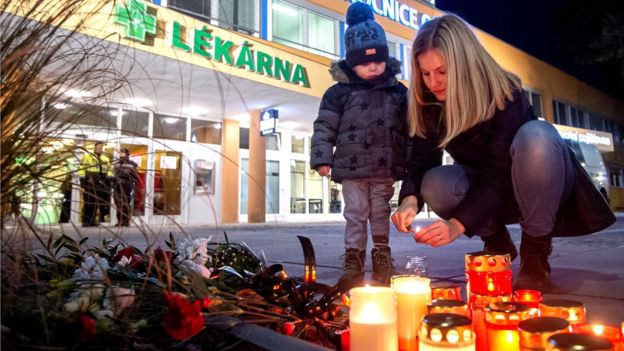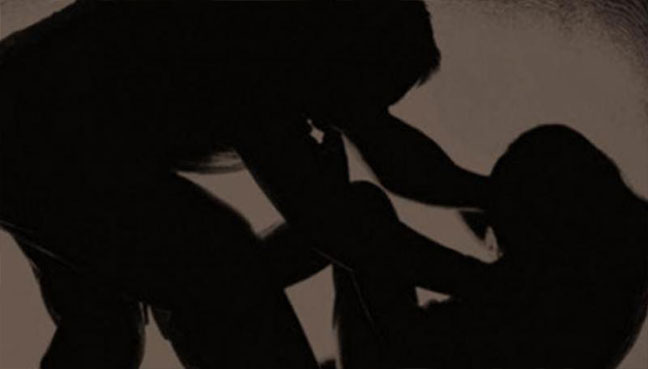Czech Shooting: Gunman Kills Six At Hospital In Ostrava
- Home
- Czech Shooting: Gunman Kills Six At Hospital In Ostrava

Czech Shooting: Gunman Kills Six At Hospital In Ostrava
A gunman has killed six people in a hospital waiting room in the Czech city of Ostrava before shooting himself in the head, police say.
Armed police found the suspect dead from a self-inflicted gunshot in a vehicle three hours later.
The gunman was believed to be a patient at the hospital, one unconfirmed report said. His motive remains unclear.
Officers said they were called to the hospital in the north-eastern city at 07:19 (06:19 GMT).
The shooting took place in a matter of moments at Ostrava university hospital’s trauma clinic. Hospital director Jiri Havrlant told Czech TV the gunman opened fire without warning, hitting nine patients.
Four men and two women were killed and three other people were wounded, two seriously. All of the victims were patients at the hospital.
The hospital was initially locked down.
A doctor inside the hospital told the Aktualne website that staff had been locked in a hallway waiting for the emergency to end.
One eyewitness, Iwona Marusikova, told Reuters news agency that it was difficult to talk about what had happened. “I work in the blood unit here. It was horrible, I am still in shock, it is a sad event… it is awful.”
Police earlier asked for help in their search for the gunman, but warned people not to approach him, adding that the site in the Moravian-Silesian region had been “secured”.
The suspect had used a handgun and had driven off in a silver Renault Laguna car, according to police. They said they had established the 42-year-old man’s name, had photographs of him and had obtained his vehicle licence plate number.
According to Czech PM Andrej Babis the man who shot dead six people at Ostrava teaching hospital this morning was a patient at the hospital. Babis said he fled the scene and visited his mother, where he told her what he’d done and that he was going to kill himself.
— Rob Cameron (@BBCRobC) December 10, 2019
Police said that once they had obtained pictures of the suspect from security cameras they launched two helicopters to search for him. When one of the helicopters was flying over the car some 5km (3 miles) north of the hospital, the man shot himself in the head and later died of his injuries.
The gun used in the attack was described as a 9mm Czech-made handgun, which the suspect did not have a licence for.
Police initially posted an image of a man they said they needed to trace and said later he was the man behind the shooting, but they later removed the picture from their social media feed after he was found.
Patrols were stepped up at what police described as soft targets, such as schools, shopping centres and other hospitals.
Colleagues of the suspected gunman told Czech media that he had recently gone on sick leave, declaring he was seriously ill. He was said to be a construction engineer who had been treated at the hospital’s haemato-oncology department.
Prime Minister Andrej Babis confirmed that six people had been killed and that the shootings occurred at close range. He said the suspect had visited his mother at her home following the attack to inform her of what he had done.
Mr Babis then cancelled a foreign trip to travel to Ostrava, reports said.
The governor of the Moravian-Silesian Region, Ivo Vondrak, said the shooting was “a great tragedy”.
Police said that officers responding to reports of a shooting had arrived at the scene within five minutes. Ostrava is about 300km (190 miles) east of Prague.
Police later offered their condolences to the families and staff affected by Tuesday’s shooting and thanked the public for their assistance throughout the day.
After announcing that the area was safe and that roads had been reopened, members of the public visited the hospital to lay flowers and light candles.

Gun attacks in the Czech Republic are rare, although gun ownership is relatively high for Europe because of the popularity of hunting.
In 2015, a man opened fire in a restaurant in the eastern town of Uhersky Brod, killing eight people before turning the gun on himself.
Last week, the Czech government lost a legal challenge to an EU law restricting private use of semi-automatic rifles. It was introduced by the European Union in 2017 after a spate of militant Islamist attacks in 2015.
The government in Prague said the law would do nothing to increase security.
Source: BBC
Classic Ghana
Classic Ghana brings you into a fun world of arts, entertainment, fashion, beauty, photography, culture and all things in between. Let’s explore these together!


